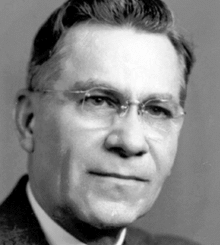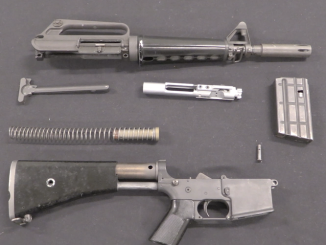In 1785, Joseph Belton (an American inventor) and William Jover (an English gunmaker) sold 560 repeating flintlock rifles to the British East India Company. The guns were a very remarkable design which used a detachable magazine tube of 7 rounds stacked in series with a seven sequential touch holes. When the first round was fired, the flintlock ignited a piece of “portfire” slow match that would burn for about one minute. Pulling the trigger would move the portfire rearward one touch hole at a time, firing each in sequence as long as it remained burning. In this way, Belton advertised the gun as being able to fire 21 rounds in a single minute (using three preloaded magazine tubes). If the portfire burned out, it could be replaced and the flintlock reprimed and recocked. This was a truly impressive technological feat in 1785!
Belton had been working on firearms designs since 1758, and he actually got an order for 100 roman-candle-type repeaters from the American Continental Congress in 1777 – but there were pricing disputes and the order was never fulfilled. The British military examined the guns, but declined to purchase any. The 560 guns made for the East India Company (200 muskets, 160 carbines, and 100 pairs of pistols) were shipped from England in 1786, half to Madras and half to Bengal. Unfortunately, no further record of their performance has been found and we don’t know how well they worked in practice. This example is one of the muskets, with a .665″ bore and a 39 inch barrel.
Many thanks to the Royal Armouries for allowing me to film and disassemble this amazing early repeater! The NFC collection there – perhaps the best military small arms collection in Western Europe – is available by appointment to researchers:
https://royalarmouries.org/research/national-firearms-centre/
You can browse the various Armouries collections online here:
https://royalarmouries.org/collection/




So much for the argument that the Founders didn’t and couldn’t have known about “automatic” weapons…
I did not know about Belton, or his sales to the US Congress. This is not a well-documented weapon system; I thought I’d been reasonably well-informed on the technology back then, and while I knew about the various “Roman Candle” systems and all the multi-barrel weapons, this one is something I’ve never read about, or even vaguely heard of.
Fascinating.
“(…)Founders(…)”
For who is that euphemism used there?
“(…)knew about the various “Roman Candle” systems and all the multi-barrel weapons, this one is something I’ve never read about, or even vaguely heard of.(…)”
If this weapon is too advanced but said Roman Candle system is not advanced enough for your purposes then use Kalthoff Repeater (early) https://firearmshistory.blogspot.com/2014/02/the-kalthoff-repeater.html which is wheel-lock magazine weapon.
Founding Fathers of the United States. The Left likes to argue that said founders could not have imagined auto weapons and so the 2nd Amendment is outdated. In point of fact, that Amendment safeguards Yanks right to strut and bluster about “cold dead fingers” while caving in to every whittling away of what were freedoms
Our history shows that militias were expected to assist in the eternal war to seize native lands. Even better, once the militia members were personally armed, there was little stopping them from attacking natives outside of their “official” actions. Which in turn would trigger native reprisals, which would then excuse militia actions in “self-defense”, a tale as old as time. And in the old slave South, there were added benefits. But it wasn’t about freedom.
The proof that the right to bear arms was expected to keep Whites dominant is that Ronald Reagan himself passed a gun ban as governor of California solely to discriminate against Black radicals. If minorities or the poor organized militias to defend against oppression today, this would no longer be necessary since they would be so ridiculously outgunned and outorganized by White militias, as they were under Jim Crow.
https://www.thetrace.org/2015/11/gun-control-race-history-saul-cornell/
How many Yank cities can you go outside after dark in now? It is not gangs of maurading Norwegians you have to avoid. Go say a prayer to your St. Floyd of Fentanyl.
And a mere subject is poking jabs? Ironic.
Since I can’t reply directly to his reply, I will say that at least he is honest enough to not pretend his racism distinguishes between immigrants and African-American citizens, in insinuating that ethnic cleansing or apartheid is necessary. But of course he fails to mention all the rural Whites cooking meth.
You sir, are sadly correct
Here’s something from Lewis Winant’s Firearms Curiosa (NRA reprint edition 1996);
-Winant, pp. 174-176
I might point out that while Winant thought “Belton” was “not uncommon” as a surname, two men in the same specialized line of business (gunmaking), at the same time, both named Joseph Belton, stretches coincidence like a rubber band.
Note the “semi-automatic” priming pan on the pistol. Similar setups were fairly common on flintlock “pepperbox” revolvers and four-barrel pocket pistols of the time, notably the Dogge type.
Finally, the idea of having interchangeable pre-loaded “magazines” of this type was nothing new at the time. On pp. 170-171 Winant describes the Danish espingole “Roman candle” gun, depicted in Thierbach’s Geschictliche Entwickeling der Handfeuerwaffen (Dresden 1888). It has a “magazine tube” and latch almost exactly like the Jover & Belton, but only a single touch-hole at the front end.
“Espingoles” were use as “rampart guns” in Denmark’s military at least as far back as the 1750s, and with a neighboring ruler like Frederick II (the Great) of Prussia (ruled 1740-1786) it’s no wonder. It’s a pretty reasonable assumption that Belton got the idea at least initially from the Danish design.
Finally, the “odd” sliding flintlock isn’t so odd after all. Double-barreled “fowling pieces” and even some rifles with side-by-side barrels were common sporting arms among the gentry in England and on the Continent at that time. To say nothing of double-barreled “overcoat pistols” carried to deter highwaymen. The “sliding” locks on the Jover & Belton guns are pretty obviously simply slightly modified left-hand locks built for such “double-barrelled” arms.
Just because Jover put his name on the lockplate is no guarantee that he made it himself.
clear ether
eon
The other, most likely, possibility is that the Belton who invented this gun system was related to a man, or men, who were involved with running the Eat India Company.
The history of the British East India Company is a ‘Game of Thrones’ story.
Interesting concept, but I see a possible design flaw (besides the whole repeating mechanism being difficult to make and fragile). Did the gas/flame from subsequent charges jet out of the port holes for previously fired charges? I can see some soldiers with severe burns on their arms and face.
I wonder about those “safety screws” in the bottom of the stock and each magazine tube. That sure looks like about where your support offhand will naturally go. I suppose losing a hand is better than a faceful of explosion.
Joseph Manton put platinum blowout plugs in the sides of his barrels on almost every type of gun he made, from rifles down to muff pistols. Being just in front of the touch-hole, the idea was that if it blew, the blast would go straight out to the side, away from the shooter.
The screws in this example were probably used because the sort of soldiers the East India Company hired “locally” could be expected to melt out platinum “plugs” and sell the resulting “nuggets”.
The real story of the background of the Sepoy Rebellion (May-July 1857) is little known in the West even today, and too long to go into here.
(Although you could read Uller Uprising by H. Beam Piper at Project Gutenberg. Piper largely based it on that historical original.)
clear ether
eon
I always heard a rumor started or was started that the new paper cartridge was lubed with beef or pork fat. The former anathema to Hindus, the latter to Muslims.
Hindu nationalists spread the rumor about beef fat, Muslim agitators were the origin of the pork fat story.
In fact, the bullets (not the paper cartridges, which were not lubed) were always lubed with sheep tallow, because it was (1) easily and cheaply obtainable in England and (2) remained solid over a wide temperature range, unlike the other kinds of fat products.
In other words, the bullet lube was fundamentally the same thing as candle wax.
cheers
eon
@ Bart;
I’d say that the main problem would be remembering not to “choke up” on the forearm with your off-hand. Most people being right-handed, that would likely result in at least lightly grilled fingertips.
cheers
eon